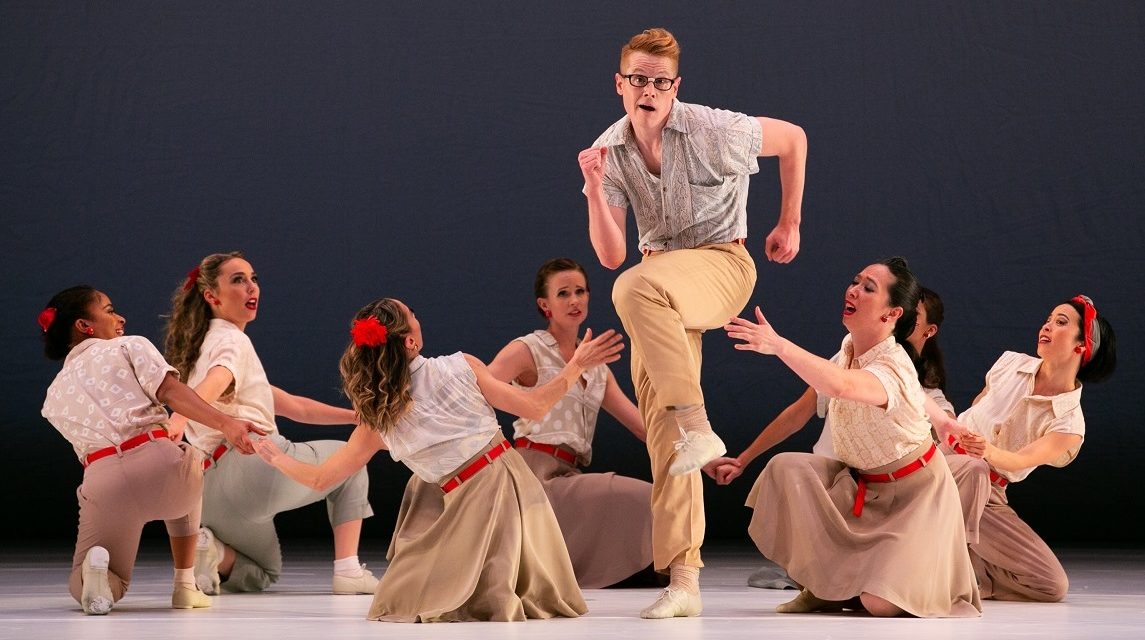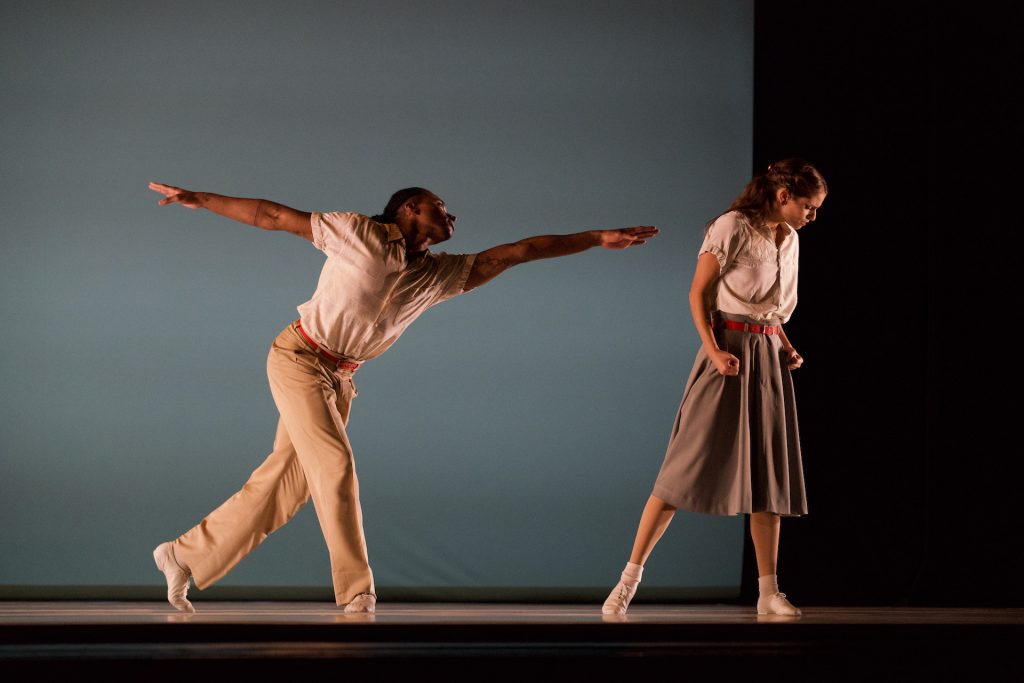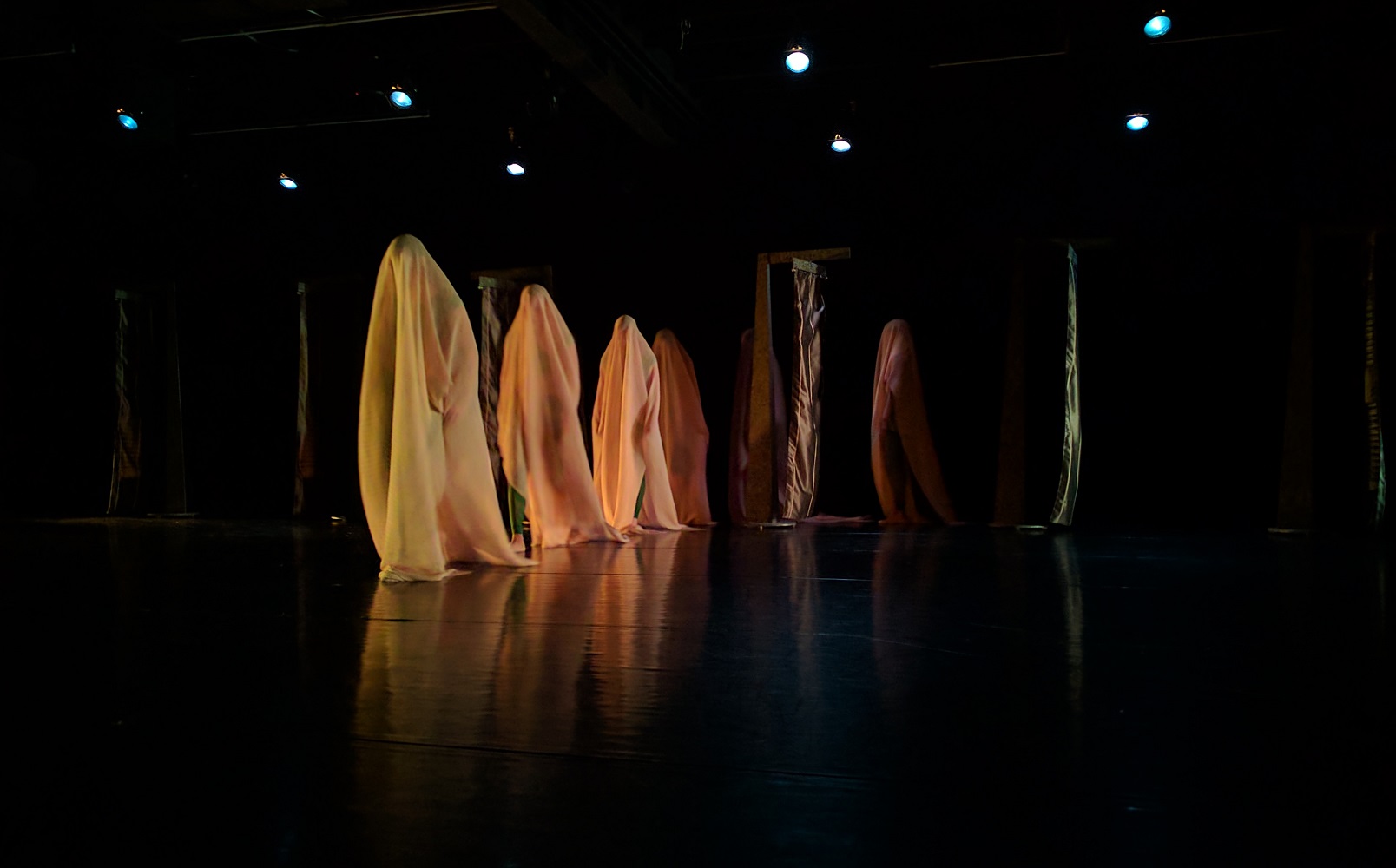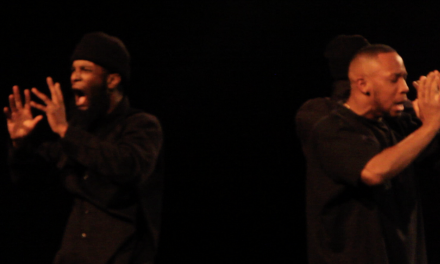As our lives have changed through the Pandemic and again facing war on a loop in everyday news, Glorya Kaufman Presents Dance at the Music Center has scheduled a glorious new season of Dance to uplift the spirit like only good art can. And with that, the much-anticipated Paul Taylor Company (founded in 1954) performed on April 28 -30, 2023. The program consisted of the brilliant The Green Table by Kurt Jooss, a classic Paul Taylor Company B, and a work by the company’s new Resident choreographer.
Company B when premiered in 1991 was uplifting and joyous. The immediacy of the swing era in dance and music matched the spirit of dervishes moving into a state of ecstasy, with the subtext of WWII looming in the collective consciousness. Taylor’s wonderful sense of irony, intelligence and style, was able to embrace the duality of romance and the addictive energy and music of the 1940’s. It was juxtaposed against the subtext of war, with silhouetted men aiming guns, or dying in slow-motion warfare.
In this evening, the sense of the era was muted. Missing were the levels of Taylor’s talent for evoking time, place and relationships that he and his company conveyed so expressively. Costumes by Santo Loquasto and lighting by Jennifer Tipton against a pastel scrim, was also understated as though being watched through smokey glass. There were, however, some wonderful moments that stood out; The “Boogie Woogie Bugle Boy,” performed by the engaging John Harnage, so agile, with an excellent sense of humor and musicality awoke memories of the origin of this piece. And the saucy petite Madelyn Ho in “Rum and Coca Cola” not only charmed the gentlemen falling to their knees in front of her, but the audiences clearly enjoyed the romp.
Next came the anticipated premiere of the work Dreamachine by Lauren Lovette, formerly of the New York City Ballet, who snagged the prize resident choreographer position with the Taylor Company. She attempted to add a contemporary twist to the evening. Her hope was that this would be her “playground” … a “sense of exploration.” As Lovette stated, “I’m a child again, about to launch my imagination into its own universe.” And launch she did.
There are three movements, DaVinci’s Wings, Electric Eel, and Vulcan’s Forge. Most interesting about this work was the music composed by Michael Dougherty, who recorded expressive and dynamic program-music for each section. Unfortunately, it did not manifest on stage. All one really had to do, however, is close their eyes and imagine one’s own dream and you’d be fine.
The first movement is a naïve claustrophobic cell of a piece, with a fluorescent ceiling grid, raising and lowering simply creating affect without reason. Both costumes and sets were designed by Loquasto with lighting by Tipton. Kristin Draucker, a stunning redhead in an orange flared dress with Eran Bugge in his orange jumpsuit introduce the piece. Instantaneously it was clear that workshopping this idea might have been helpful since their wanderings were clearly not yet ready for prime time. Soon came an invasion of robots, so timely, yet so extemporaneous. Bodies in shiny military-looking uniforms appeared… for no reason. They walked in, lifted other bodies and posed threateningly, creating unsubstantiated peril that might have been staged more effectively by a stunt coordinator. If there was a story, the arc was missing.
Second movement was a pas de deux called electric eel, the significance was unclear. Jessica Ferretti met up with Kenny Corrigan wearing his “Heelys” (tennis shoes with wheels on the heels) which initially surprised and delighted the audience. They romped about with an occasional awkward lift, and intermittent glides across the stage by Corrigan. After more than enough gliding without a new idea, it was clear the gimmick had lost its charm, as did the Pas de deux. And finally The Vulcan’s Forge with a full cast dressed in militia khaki jumpsuits. First gathering as fierce looking combatants, then threatening without context, at times constructing pyramids for no reason. In some cases even wandering the stage with nothing to do but change positions. The end of the piece came none too soon.
Finally, the most anticipated piece of the night, The Green Table, the timeless work of the brilliant German Choreographer, Kurt Jooss who experienced his own threat of Hitler’s Germany. Foreshadowing WWII, Jooss was asked to dismiss all Jewish and half Jewish members of his company, composer F.A. Cohen among them. Upon his refusal to do so, all had to flee from the Nazis via Netherlands to England. His piece is deeply human and humane, with such important historical context and messaging, done not in words but in the action and expression of the dancers.
It is a treasured memory of Joffrey and Jooss working together to give the piece the power and dramatic intent it deserved. When Maximiliano Zomosa and Christian Holder, Holder being the inheritor of the role of “Death” after Zomosa’s untimely passing at 31, were both well over 6 feet, and powerful in their presence as “Death”. They inspired the other dancers (the mother, the Standard Bearer, the Profiteer, etc.) to intensify their performances, resisting and then relinquishing Death’s seduction. Holder was clear in his dedication to Jooss and Zomosa’s memory, “You carry an incredible legacy with you, not only in your own accomplishments but also the legends who informed your work over the years.” (C. Holder)
Even though some consider this to be a relic of the past, its incessant beat of fists on the iconic table, matched by the unceasing blows of Death’s boots stomping and scraping the blood off his shoes from the killing fields (imagery Jooss used to characterize Death’s job in War) is a warning for the future. It is profoundly contemporary and unfortunately it appears it will always be. It is to Dance, what Shakespeare is to Theatre. As Jooss reminds us, “The only winner in War is Death!” And so it is from the diplomat’s meeting rooms, where deals are made and broken at the table, to the blood soaked killing fields, those that initiate conflict of war keep going uncaring and unscathed.
Having seen Joffrey’s stunning version and speaking to those who were in the room where it happened with Jooss’ full power of imagery, this piece has personal significance. That is why there are many concerns in this iteration that seems phoned in, disregarded and muted without the timing of each scene marching one-after-another. The limp characterizations, except for the good work of Harnage’s snake-like Profiteer, the innocence of Jada Pearman (young girl), and old mother by Maria Ambrose were a moving representation. However, Shawn Lesniak’s weak near disappearance as “Death” missed so many opportunities. The use of sound so much a part of his character, the pulsating and threatening incessant stamping of his boots against the blood-soaked fields was nearly absent. The use of levels; fully bending, hiding in the dark corners, then appearing to grow to full height and power; this imagery, if passed on to the performing cast would have evoked the chilling dominion of the ever-present apparition, and thus the threat would be felt by all.
Lighting direction by Kevin Dreyer was not quite up to the intensity of the moment, yet costumes by Hein Heckroth were still preserved, with the original effective Masks and Lighting recorded painstakingly by Hermann Markard. The piano works by David LaMarche and Blair McMillen’s was a powerful remembrance of the choices made to keep The Green Table “frill-less” but chilling.
The questions is, was it possible to be so wrong after all these years? Was what was seen so many years ago, only in the mind? To solve this question, I made time to see the piece again on the final day. With that, the conclusion was clear.
The Paul Taylor Company appears new, trying to find its footing after 60 plus years of powerful leadership and creativity. The handing off of the baton to the new Artistic Director, Michael Novak, needs rebuilding with the expertise of a master surgeon. It is my hope that the company rises to the occasion and once again thrills audiences with the spirit and technical elan that will create new memories for audiences to come.
For more information about The Paul Taylor Dance Company, please visit their website.
For more information about Glorya Kaufman Presents Dance at The Music Center, please visit their website.
Written by Joanne DiVito for LA Dance Chronicle.
Featured image: Paul Taylor Dance Company in Taylor’s Company B – Lee Duveneck (center) – Photo by Whitney Browne













